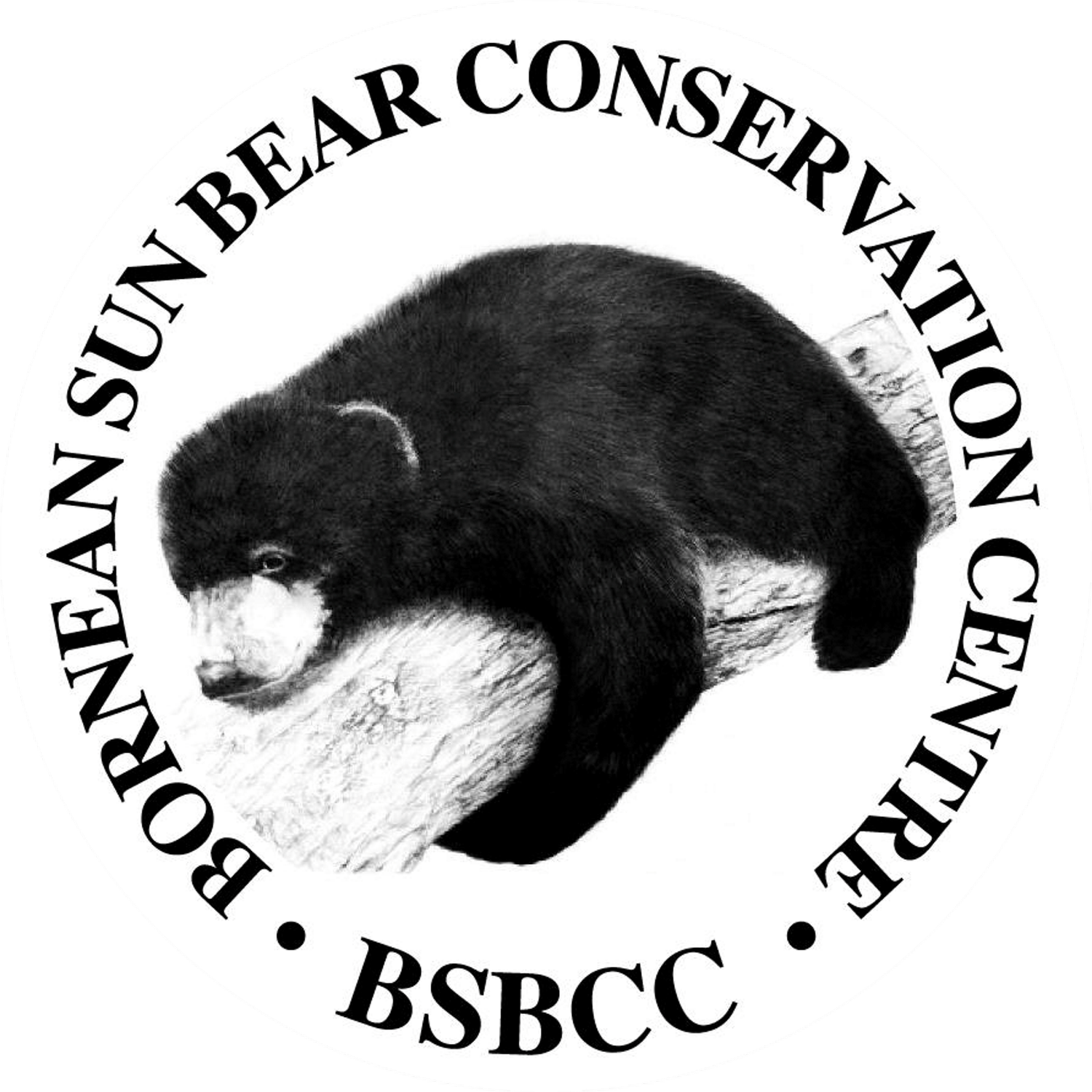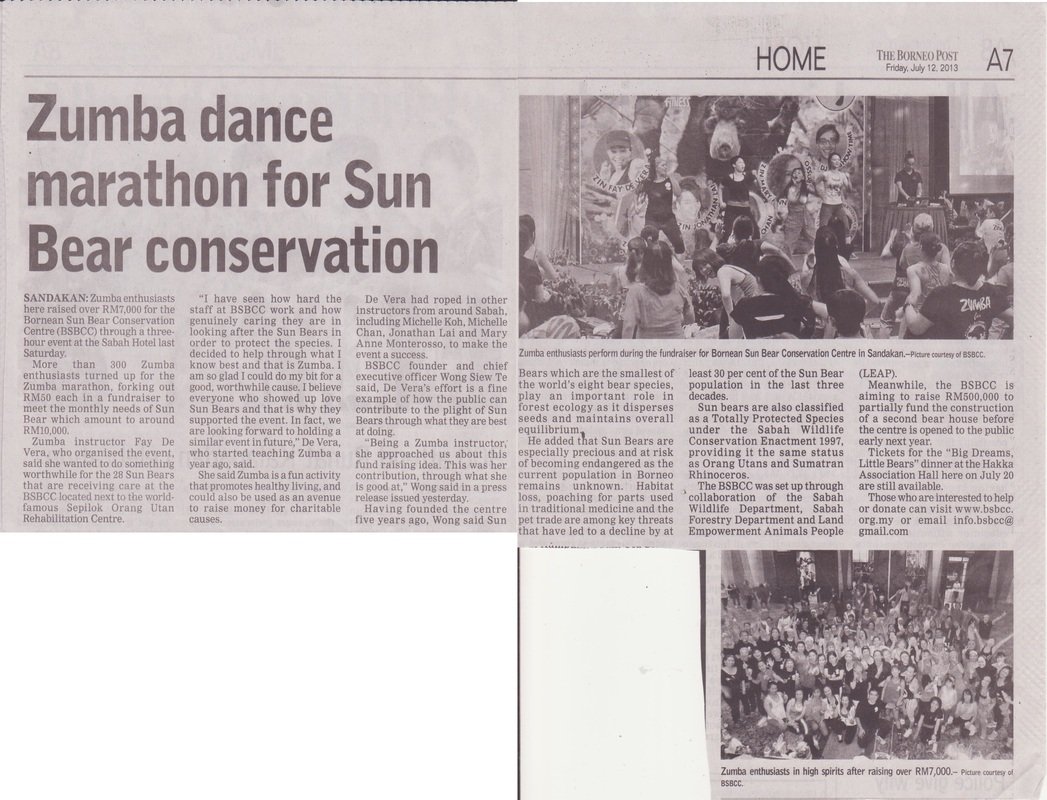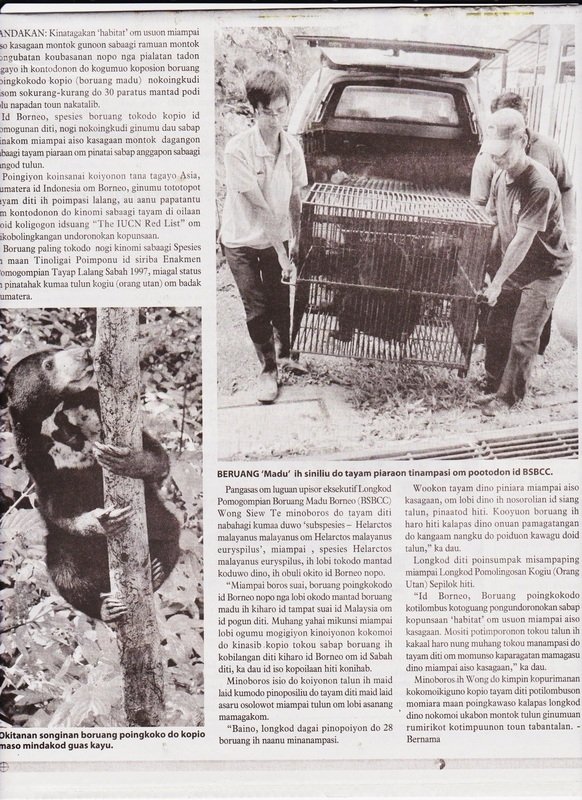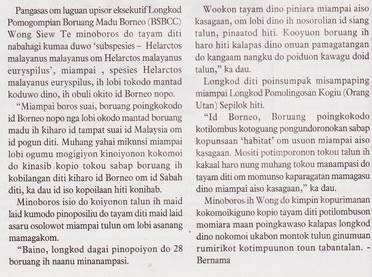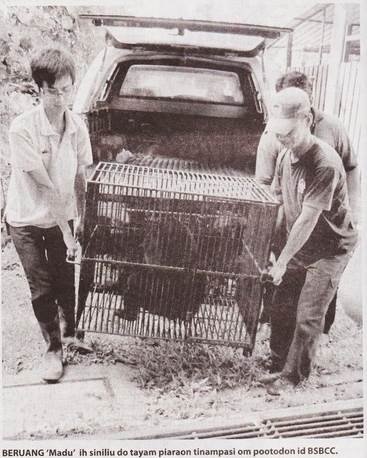Special Moments with Wan-Wan and Mamatai in the BSBCC Forest Enclosure
It all begins with an idea.
Part I
Text and Photos by Chiew Lin May
On August 14, 2013 Wan-Wan, a seven year old female sun bear and Mamatai, an eleven year old female sun bear were released into the forest enclosure. The two bears are very different in appearance; Wan-Wan has a light pinkish nose and Mamatai has short legs and a stocky build. The two bears arrived at the BSBCC together from the Lok Kawi Wildlife Zoo, and have become quite the pair.
First steps to freedom!
Wan-Wan who known as "Light Pinkish Nose" was took a peek though door.
Mamatai (in Dusun language) mean aggressive attitude and she also known as "The Fatty".
Wan-Wan try to get back in bear house.
For the first time in their lives, Mamatai and Wan-Wan have a safe place where they can live a peaceful life in a natural habitat. In the forest enclosure they can roam around, dig in the soil, rest in the tall trees, and truly enjoy the natural forest.
Once the door was opened, they were very eager to get out into the forest enclosure, but are carefully observing their new home; studying unknown scents, sounds, and movements around them.
Both of the sun bears is starting to learn what to eat in the forest.
I am in the real forest!
Using her keen sense of smell, Wan- Wan is very focused on digging in search for invertebrates.
A long and agile tongue for reaching into termite colonies.
Wan- Wan is scenting her new surroundings.
Mamatai is so happy and enjoys the freedom in forest.
Mamatai likes to spend most of her day sleeping and sunbathing under the tree.
Mamatai enjoys eating the King of Fruits-Durian.
Sun bears are important for seed dispersal in the forest ecosystem. After Sun bear eat the fruit, they will disperse the seeds in forest.
Sun bears are very good at skimming through the jungle to find any kinds of food (insects) they can get their paws on.
I am become a tree hugger bear!
Mamatai climbs a tree for a better look.
She learn how to split open the decayed wood and dig for termites and other insects
Over the next few months both bears will be learning, growing, and enjoying life within the forest enclosure.
Sun bears are a very important part of the ecosystem and more people need to know why they are so important while there is still time to save them. Please lend a helping hand and spread the word. The sun bears need you!!
Thank You For Your Support of The Big Dreams, Little Bears Fundraiser !!
It all begins with an idea.
Thank you all our donors for your generous support for our BIG DREAMS LITTLE BEARS fundraiser, Sandakan.
Your contribution generated RM443,000 for the Bornean Sun Bear Conservation Centre - the first sunbear centre in the world for the smallest bears in the world!
Contribution is underway and we hope to have the centre open by 2014! See you there soon !
Outlet in Hot Water Over Exotic Menu
It all begins with an idea.
The Star Online, 22th August
BY YUEN MEIKENG
Abdul Kadir (left) and Perhilitan officers showing the seized exotic meat during the press conference in Kuala Lumpur.
KUALA LUMPUR: Apart from standard fare, the kitchen of a restaurant in Cheras was allegedly serving up exotic dishes featuring bear’s foot and tapir’s nose under its “special order” menu.
Department of Wildlife and National Parks (Perhilitan) enforcement officers raided the restaurant and seized 2.95kg of bear flesh, 1.2kg of pangolin scales, three soft-shelled turtles, 20 bats, 7.4kg of wild boar parts and other types of exotic meat.
“The animal parts were found in the kitchen and freezer of the restaurant during a raid by the Perhilitan wildlife crime unit,” said Perhilitan enforcement director Abdul Kadir Abu Hashim during a press conference here yesterday.
He said Perhilitan officers had observed the restaurant for two months before making their move because the exotic meat was not offered daily.
“The demand for the dishes is high. The average price of an exotic dish sold by the shop is about RM60.
“Those featuring bear’s foot or tapir’s nose should fetch higher prices,” Abdul Kadir said.
Two restaurant workers – a man and his sister, both in their 40s – were arrested to assist in investigations but were granted a RM15,000 bail each with two sureties.
The pair are expected to face court charges on Sept 19.
Among others, the case falls under Section 68(1)(b) of the Wildlife Conservation Act 2010 for taking or keeping any part of a totally protected wildlife without a special permit.
Those convicted can be fined up to RM100,000, jailed up to three years or both.
Abdul Kadir said Perhilitan officers also raided four restaurants in Kedah for similar offences and made similar seizures that included what is thought to be the head of a clouded leopard.
“There have been 78 cases involving wild boar meat, five involving bats and four involving tapir parts reported since 2006,” he said.
MALAYSIA: A Sneak Peak at the Borneo Sun Bear Conservation Centre
It all begins with an idea.
Green Global Travel, 21st August 2013
–by Leyla Giray Alyanak; photos by Anne Sterck
Sun Bears Are Identified By Crescent-Shaped Patches on Their Chests
(The following is a guest post by Leyla Giray Alyanak, a former foreign correspondent who belonged to the WWF International management team, and now blogs about her travels at Women on the Road. If you’re a blogger interested in contributing a guest post, please contact Bret Love at GreenGlobalTravel@gmail.com.)
When the Borneo Sun Bear Conservation Centre opens its doors to the public in early 2014, visitors will be treated to a rare sight: 28 of the world’s smallest bears, as curious about us as we are about them.
I was fortunate to get a sneak peek behind the scenes at the BSBCC on a recent visit to the Malaysian state of Sabah. Everything is set: The visitor center and a second bear house are being built, and half a dozen cubs are already clambering over tree trunks and branches, looking around with mischief in their eyes.
Guaranteeing the Sun Bear’s survival in Borneo is one of the main reasons behind the conservation centre, and protecting its rainforest habitat is part of the centre’s mission. Unfortunately, Helarctos malayanus has been under serious threat throughout the rest of its range. In some places, including Bangladesh, China, India, Myanmar and Vietnam, it has all but disappeared.
Curious Cubs Check out Photographer Anne Sterck
Sun Bear Facts
The Sun Bear is a diminutive creature– the smallest of the world’s eight bear species. An adult male stands at about 1.5 meters (or five feet) in length, around the size of a large dog. Known as a “honey bear” (for its appetite) or “dog bear” (for its size), it is jet black, with a crescent-shaped patch across its chest. It also has a distinctive long, thin tongue, which it uses to delve into honeycombs, ant hills and termite mounds. The Bornean Sun Bear, Helarctos malayanus euryspilus, is the smallest of the two sub-species.
Some scientists believe there may be only 10,000 Sun Bears left in the world. It’s hard to tell, though, as mistaken sightings and rare species surveys have made estimates unreliable. According to the IUCN Red List of Threatened Species, the global Sun Bear population may have declined by up to 30% in the past 30 years, which is the equivalent of three bear generations.
The IUCN Map of the Sun Bears’ Range
Sun Bears Under Attack
Sun Bears are protected in Malaysia, and the IUCN classifies them as “vulnerable.” But that doesn’t mean they’re safe.
Sun Bears need the forest to survive, but much of Sabah’s rainforest has been cleared for palm plantations. Fly from Kota Kinabalu to Sandakan and you’ll notice orderly rows of commercial palm trees, like a polka dot pattern across the land. Logging for hardwood trees has also helped destroy forests, leaving behind fragments too small to provide Sun Bears with a suitable habitat. Clearing continues, although the government has taken action to protect large tracts of land in a last-ditch effort to save one of Southeast Asia’s few remaining major tropical forests. Still, many conservation groups fear that isn’t enough, and the past destruction can’t be reversed.
“Given the Sun Bear’s dependence on forest,” says a 2008 assessment by IUCN, “it is clear that the large-scale deforestation that has occurred throughout Southeast Asia over the past three decades has dramatically reduced suitable habitat for this species.”
Sun Bears’ Cuddy Cuteness Leads to Being Kept Illegally as Pets
Sun Bears are often victims of poaching, especially for the illegal trade in wildlife body parts. Their meat is still eaten in some parts of Borneo (mostly in Indonesian Kalimantan, although this is increasingly rare), and the bile from their gallbladders is highly prized in traditional Chinese medicine.
As if all that weren’t enough, the little bear can face attack by other animals, like large cats, although this tends to occur more in Sumatra or on the Asian mainland. Snakes can occasionally be a threat. One female Sun Bear was swallowed whole by a reticulated python while she was asleep.
But one of the most pervasive threats to Sun Bears is the human desire to own them as pets. Many of the Borneo Sun Bear Conservation Centre’s animals have been confiscated from owners who didn’t even know they were breaking the law. So there’s clearly a pressing need for public education. But, even when the laws are known, they are often ignored, despite strong sanctions that include fines of up to RMY 50,000 (about $15,000) and five years in prison.
Still, rangers keep finding pet cubs. “It’s a very bad situation,” said Malaysian wildlife scientist and bear expertWong Siew Te, the founder of the BSBCC. “When held captive in small cages, some of them have gone crazy or exhbited odd behaviours. So setting up this centre was urgent.”
Help Is At Hand
Dr. Wong, a former co-chair of the Sun Bear Expert Team for the IUCN/SSC Bear Specialist Group, hatched the idea for BSBCC after witnessing the Sun Bears’ suffering first-hand while doing his Masters of Science research.
“I often visited places where they were held in captivity– in small cages, mini-zoos or private homes, often in disgusting conditions,” he recalls. “They all suffered badly. Some were cubs, others were adults, but all were desperate for space. It left me heartbroken, and that’s how I first got the idea for the BSBCC.”
Back in 2008, that dream started taking shape with the rescue of seven Sun Bears and a partnership with the Sabah Wildlife Department, the Sabah Forestry Department, and the NGO Land Empowerment Animals People (LEAP). The sanctuary started from scratch with an old bear house, where rescued bears were held by the Forestry Service. An initial fundraising effort of $4000 was enough to build the first proper bear house, but fundraising for Sun Bears is not easy. Donations tend to go to the larger, more popular charismatic megafauna.
“Sun Bears aren’t very well known,” Dr. Wong explains, “so many NGOs have not wanted to work with them, preferring better-known species like orangutans, elephants, rhinos and so on. The Sun Bear is facing a dark era.”
A Shy Cub Plays Peek-A-Boo Behind a Bush
Today, 28 orphaned bears share the BSBCC’s 2.5 hectares of natural forest environment. And soon everyone will be welcome to see them. The centre will house the bears in both forest enclosures and in a specific expanse of woods designed to teach them how to live in the forest after many years of captivity. Those who can’t be rehabilitated will at least be able to thrive in a decent environment.
In addition to protecting the bears and their habitat, the BSBCC also wants to raise awareness about this relatively unknown species. Not just locally, but also globally. “It’s a holistic approach to Sun Bear conservation,” Dr. Wong explains. “It involves animal welfare, rehabilitation, research and education. It’s the first facility of its kind in the world.”
The BSBCC is rushing to open in time, working diligently to overcome slight bureaucratic hitches around permits and paperwork. But, according to Dr. Wong, “All is on track.” The sanctuary has just 11 people on staff– far fewer than needed– but hundreds of local and international volunteers have proven willing to help out. The Centre also has a volunteer program for travelers who would like to work more closely with the Sun Bears, or students who wish to learn more about these adorable creatures.
Fortunately, the fact that the BSBCC is located next to the Sepilok Orangutan Rehabilitation Centre and the new Rainforest Discovery Centre means it can likely expect to receive a steady stream of visitors who are fascinated by wildlife. If you are among these visitors, just know that the Sun Bears will surprise you. And, judging by the looks they gave us during our visit, you’ll surprise them, too.
If you enjoyed reading about the Borneo Sun Bear Conservation Centre, you might also like:
INTERVIEW- Jill Robinson & Animals Asia Fight to Stop Bear Bile Farming
INTERVIEW- WWF Biologist Geoff York On Saving Polar Bears
CHURCHILL- Polar Bear Fight
CHURCHILL- Polar Bear Photo Gallery
NORTH CAROLINA- Black Bears At Alligator River National Wildlife Refuge
Saving Sabah's Sun Bears
My Sinchew, 17th August 2013
By Haslin Gaffor
SANDAKAN, Aug 17 (Bernama) -- Bongkud was seen climbing up a tree in search of food within the gated area of the Bornean Sun Bear Conservation Centre at the Kabili-Sepilok Forest Reserve, near here.
These are good days for the Bornean sun bear which is now free to carry on with its natural activities in the 0.32 hectare forest enclosure compared with his 'captive days' in the past.
The sun bear was rescued by the Sabah Wildlife Department in June 2012 following a tip-off from a tourist who had seen the animal being kept in a small pen by a villager in Kampung Bongkud, Ranau.
Following the rescue, the bear was sent to the conservation centre and was named after the village where he was rescued -- Bongkud.
Bongkud is now two-years old and is among the 28 sun bears being taken care in the conservation centre. The sun bears are the world's smallest bears and their numbers have been dwindling over the years.
Conservation centre
The conservation centre, opened in 2008, is the first such centre in the world dedicated to caring for sun bears.
Located next to the Sepilok Orang Utan Rehabilitation Centre, the place also serves as a centre of information on sun bears and carries out various awareness programmes to educate the public on the animals.
A mammal, the sun bear is divided into two sub species namely Helarctos malayanus malayanus and the even more smaller sized Helarctos malayanus euryspilus which can be found only in Borneo.
Found throughout the mainland of Asia, Sumatra in Indonesia and in Borneo, the sun bears are already classified as endangered species under the IUCN Red List of animals under the threat of extinction.
These creatures are hunted illegally for use in traditional medicines as well as in the preparation of exotic dishes. These are among the major reasons for the drop in the sun bear population, at least by 30 percent, in the last three decades.
In Sabah, the bears' habitats are mainly in the low-lying forest areas, specifically in the conservation areas of Maliau Basin, Danum Valley and Imbak Canyon.
However, the population density of the bears in the state's forest reserve areas remains low.
Education
The focus of the centre currently is on the rescue of sun bears being kept in illegal captivity and those whose natural habitats are being threatened by human activities.
Wong Siew Te, the centre's founder and chief executive officer said the conservation efforts involved three stages, namely identifying threatened sun bears and bringing them to the centre, rehabilitate them and finally free them back into the forest areas deemed safe.
The 28 bears in the centre, made up of 21 sows and seven boars, are between one and 20-years of age. They would be released into the forest next year once the rehabilitation period is over.
Another area of focus for the centre is in educating the public on sun bears, Wong said, adding that little is known about the bears locally and internationally.
Wong, who has been actively involved in the conservation of bears the last 15 years, said many were not even aware that the laws protect the sun bear and it would be illegal to hunt, keep or eat them!.
Due to the lack of knowledge on sun bears, many think that they are from the same family as the Panda bears found in China.
Many are also not aware that the sun bears are fully protected species under the Sabah Wildlife Conservation Enactment 1997, and have been given the same protection as the orangutan and Sumatran rhinoceros.
Under the enactment, those found owning a sun bear or its products, can be fined up to the RM50,000 or jailed for five years, or both.
Research
Wong said another important focus for the centre is research, encompassing the areas of ecology and biology, adding that there was insufficient data on the sun bears in the country and region.
"I too carried out research for six years on the bears in the forest while completing my degree but there is still so much still unknown about them, including their total numbers in the country, in the state and in the world," said Wong, who has a degree in Wildlife Biology from University of Montana, US.
Wong, currently preparing his PhD thesis at the same university, stressed that there was a need to protect the species before being wiped out by human activities.
Demand for its bile
Wong said the locals in Borneo believed that the sun bear's bile had restorative properties and capable of curing injuries.
"This may be the reason why the sun bears are hunted... for their bile and meat," said Wong, who is from Georgetown.
Due to the high demand from the locals, there is rampant illegal selling of the its fresh meat, its bile in capsules, and other parts in traditional medicine shops.
Clash with humans
In Borneo, the decline in the number of the species continues with their illegal capture for sale as pets and at times they are also killed when they are seen as an enemy of man.
The disappearing forest areas and encroachment of their natural habitat has also exposed the animal to more humans and made them more vulnerable to being hunted and caught.
There is an urgent need to conserve the remaining forests in order to save these animals and also stop the illegal hunting of them, Wong said.
To be open to public
Meanwhile, to expose more people to the conservation efforts taken for the sun bears, the centre is expected to be opened to the public once it is fully completed and several facilities are put in place.
Currently, the centre has a building called Bear House to house all the bears.
The bears in the centre eat four times a day and their diet consists of vegetables, fruits, eggs, rice, and meat, and the cost of feeding all the 28 bears amount to RM10,000 a month.
The sun bears are naturally ant, termite and insect eaters and play an important role in the eco system, in the distribution of seeds and also in the control of termite population.
At the centre, there are 11 full time staff currently as well as four volunteers from other countries.
The centre greatly welcomes volunteers from student communities both from overseas and locally including from Europe, United States and Asia. Some of the volunteers are also doing their research in the centre.
Helping To Save The Sun Bears Of Sabah
BERNAMA, 17th August, 2013
By Haslin Gaffor
SANDAKAN (Bernama) -- Bongkud was seen climbing up a tree in search of food within the gated area of the Bornean Sun Bear Conservation Centre at the Kabili-Sepilok Forest Reserve, near here.
These are good days for the Bornean sun bear which is now free to carry on with its natural activities in the 0.32 hectare forest enclosure compared with his 'captive days' in the past.
The sun bear was rescued by the Sabah Wildlife Department in June 2012 following a tip-off from a tourist who had seen the animal being kept in a small pen by a villager in Kampung Bongkud, Ranau.
Following the rescue, the bear was sent to the conservation centre and was named after the village where he was rescued - Bongkud.
Bongkud is now two-years old and is among the 28 sun bears being taken care in the conservation centre. The sun bears are the world's smallest bears and their numbers have been dwindling over the years.
CONSERVATION CENTRE
The conservation centre, opened in 2008, is the first such centre in the world dedicated to caring for sun bears.
Located next to the Sepilok Orang Utan Rehabilitation Centre, the place also serves as a centre of information on sun bears and carries out various awareness programmes to educate the public on the animals.
A mammal, the sun bear is divided into two sub species namely Helarctos malayanus malayanus and the even more smaller sized Helarctos malayanus euryspilus which can be found only in Borneo.
Found throughout the mainland of Asia, Sumatera in Indonesia and in Borneo, the sun bears are already classified as endangered species under the IUCN Red List of animals under the threat of extinction.
These creatures are hunted illegally for use in traditional medicines as well as in the preparation of exotic dishes. These are among the major reasons for the drop in the sun bear population, at least by 30 percent, in the last three decades.
In Sabah, the bears' habitats are mainly in the low-lying forest areas, specifically in the conservation areas of Maliau Basin, Danum Valley and Imbak Canyon.
However, the population density of the bears in the state's forest reserve areas remains low.
EDUCATION
The focus of the centre currently is on the rescue of sun bears being kept in illegal captivity and those whose natural habitats are being threatened by human activities.
Wong Siew Te, the centre's founder and chief executive officer said the conservation efforts involved three stages, namely identifying threatened sun bears and bringing them to the centre, rehabilitate them and finally free them back into the forest areas deemed safe.
The 28 bears in the centre, made up of 21 sows and seven boars, are between one and 20-years of age. They would be released into the forest next year once the rehabilitation period is over.
Another area of focus for the centre is in educating the public on sun bears, Wong said, adding that little is known about the bears locally and internationally.
Wong, who has been actively involved in the conservation of bears the last 15 years, said many were not even aware that the laws protect the sun bear and it would be illegal to hunt, keep or eat them!.
Due to the lack of knowledge on sun bears, many think that they are from the same family as the Panda bears found in China.
Many are also not aware that the sun bears are fully protected species under the Sabah Wildlife Conservation Enactment 1997, and have been given the same protection as the orangutan and Sumatran rhinoceros.
Under the enactment, those found owning a sun bear or its products, can be fined up to the RM50,000 or jailed for five years, or both.
RESEARCH
Wong said another important focus for the centre is research, encompassing the areas of ecology and biology, adding that there was insufficient data on the sun bears in the country and region.
"I too carried out research for six years on the bears in the forest while completing my degree but there is still so much still unknown about them, including their total numbers in the country, in the state and in the world," said Wong, who has a degree in Wildlife Biology from University of Montana, US.
Wong, currently preparing his PhD thesis at the same university, stressed that there was a need to protect the species before being wiped out by human activities.
DEMAND FOR ITS BILE
Wong said the locals in Borneo believed that the sun bear's bile had restorative properties and capable of curing injuries.
"This may be the reason why the sun bears are hunted... for their bile and meat," said Wong, who is from Georgetown.
Due to the high demand from the locals, there is rampant illegal selling of the its fresh meat, its bile in capsules, and other parts in traditional medicine shops.
CLASH WITH HUMANS
In Borneo, the decline in the number of the species continues with their illegal capture for sale as pets and at times they are also killed when they are seen as an enemy of man.
The disappearing forest areas and encroachment of their natural habitat has also exposed the animal to more humans and made them more vulnerable to being hunted and caught.
There is an urgent need to conserve the remaining forests in order to save these animals and also stop the illegal hunting of them, Wong said.
CENTRE TO BE OPENED TO THE PUBLIC
Meanwhile, to expose more people to the conservation efforts taken for the sun bears, the centre is expected to be opened to the public once it is fully completed and several facilities are put in place.
Currently, the centre has a building called Bear House to house all the bears.
The bears in the centre eat four times a day and their diet consists of vegetables, fruits, eggs, rice, and meat, and the cost of feeding all the 28 bears amount to RM10,000 a month.
The sun bears are naturally ant, termite and insect eaters and play an important role in the eco system, in the distribution of seeds and also in the control of termite population.
At the centre, there are 11 full time staff currently as well as four volunteers from other countries.
The centre greatly welcomes volunteers from student communities both from overseas and locally including from Europe, United States and Asia. Some of the volunteers are also doing their research in the centre.
-- BERNAMA
Sun Bears are "Forest Doctors"
By AVILA GERALDINE
ECOSYSTEM PRESERVERS: They cannot survive in agricultural plantations, says conservation expert KOTA KINABALU: THE Malayan sun bear plays an important role in the ecosystem as they serve as forest doctors, engineers and planters, contributing to a thriving forest.
Bornean Sun Bear Conservation Centre (BSBCC) founder and chief executive officer Wong Siew Te said the sun bear used its claws to scrape off and destroy termite nests around tree bark.
This, in turn, saves the host tree from dying because of termite infestation.
"Sun bears do this to get termites and larvae, an important food source for them.
"If they do not do this, the termites will eventually kill the host tree by feeding on the wood fibre inside.
"Uncontrolled termite populations can lead to the death of many trees," he said yesterday.
The sun bear is the smallest of the world's bears and is listed as "vulnerable" on the International Union for Conservation of Nature Red List.
It is at risk of becoming endangered, unless the circumstances threatening its survival improve.
Wong said sun bears, which lived in the forests of Southeast Asia, were fond of eating honey.
Sun bears create holes in trees when extracting the honey of stingless bees that build nests under tree bark.
The holes are then used by hornbills or squirrels to nest in.
As forest planters, sun bears spread the seeds of large fruits, such as durian and jackfruit, when travelling.
They have a home range of 14 square kilometres.
"Sun bears are among the largest mammals in the tropical rainforest.
"Through their travels, they defecate swallowed seeds away from the mother tree.
"This increases the chances of the seeds' survival.
"Through their role as nutrient mixers, sun bears facilitate soil turnover and regeneration when they forage for termites and other insects."
Despite the many functions that sun bears served, their long-term survival in the wild depended on the continuous existence of natural forests, said Wong.
He said sun bears, as a forest-dependent species, could not survive in oil palm and other agricultural plantations.
"They need large tracts of natural forests for them to sustain viable populations, where they can search for food, shelter and reproduce.
"There is so much that sun bears are doing for the forest and this is something we all need to understand and appreciate.
"Today, their number is going down and more are ending up in captivity."
Wong added that BSBCC housed 28 rescued sun bears.
The centre, which is located adjacent to the Sepilok Orang Utan Rehabilitation Centre in Sandakan, is hoping to hold a fundraiser on July 20.
This is to meet the ever-increasing cost of caring for sun bears in captivity, as well as raise public awareness of the species.
BSBCC is a non-governmental organisation set up in 2008 through a collaboration between the Sabah Wildlife Department, Sabah Forestry Department and Land Empowerment Animals People.
Kinatagakan
"habitat", magagasu tolosok kopongundoronok koposion boruang tongokodo
Utusan Borneo, 22nd May 2013
